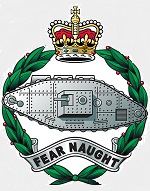Wings of the Great War WW10203 British Mark IV Male Tadpole Heavy Tank - Armored Testing Ground, Central Stores, Erin, England, 1918 (1:72 Scale)
"Through Mud And Blood To The Green Fields Beyond."
- British Tank Corps Motto in World War I
 The British Mark IV "Male" heavy tank was an up-armored version of the Mark I, with all of its fuel stored in a single external tank (located between the rear track horns) in an attempt to improve crew safety. The sponsons could be pushed in to reduce the width of the tank for rail transportation and rails could be carried on the roof to act as an unditching beam.
The British Mark IV "Male" heavy tank was an up-armored version of the Mark I, with all of its fuel stored in a single external tank (located between the rear track horns) in an attempt to improve crew safety. The sponsons could be pushed in to reduce the width of the tank for rail transportation and rails could be carried on the roof to act as an unditching beam.
The director of the Tank Supply Department, Albert Gerald Stern, first intended to fit the Mark IV with a new engine and transmission. Production of battle tanks was halted until the new design was ready, necessitating the Mark II and III as interim training tanks. He failed, however, to complete development soon enough to start production in time to have 200 tanks ready for the promised date of April 1st, 1917. Ultimately he was forced to keep the Mark IV in production until May 1917, which was only slightly different from the Mark I.
The Mark IV "Male" carried 4 Lewis machine guns as well as the two sponson guns (now with shorter barrels). The "Female" version had six machine guns, with two of the machine guns were operated by the gun loaders. All told, some 1220 vehicles were built: 420 Males, 595 Females and 205 Tank Tenders which were supply tanks.
A large number of Mark IV tanks were also used for development work. In an attempt to improve trench-crossing capability, the tadpole tail, an extension to the rear track horns, was introduced. However, it proved insufficiently rigid and does not appear to have been used in combat. Other experimental versions tested radios, mortars placed between the rear horns, and recovery cranes. Some of these devices were later used on operational tanks. Mark IVs were also the first tanks fitted with unditching beams by field workshops. A large wooden beam, reinforced with sheet metal, was stored across the top of the tank on a set of parallel rails. If the tank became stuck, the beam was attached to the tracks (often under fire) and then dragged beneath the vehicle, providing grip.
Pictured here is a 1:72 scale replica of a British Mark IV "Male" Tadpole heavy tank that underwent evaluation at the Armored Testing Ground, located at Central Stores, Erin, England, in 1918.
Sold Out!
Dimensions:
Length: 6-inches
Width: 2-1/4-inches
Release Date: March 2017
Historical Account: "Battle History" - The Mark IV was first used in large numbers on June 7th, 1917, during the British assault on Messines Ridge. Crossing dry but heavily cratered terrain, many of the sixty-plus Mark IVs lagged behind the infantry, but several made important contributions to the battle. By comparison, at the Third Battle of Ypres (also known as Passchendaele) from July 31st, where the preliminary 24-day long barrage had destroyed all drainage and heavy rain had soaked the field, the tanks found it heavy going and contributed little; those that sank into the swampy ground were immobilized and became easy targets for enemy artillery.
Nearly 460 Mark IV tanks were used during the Battle of Cambrai in November 1917, showing that a large concentration of tanks could quickly overcome even the most sophisticated trench systems.
In the aftermath of the German Spring Offensive on the western front, the first tank-to-tank battle was between Mk IV tanks and German A7Vs in the Second Battle of Villers-Bretonneux in April 1918.
About 40 captured Mark IVs were employed by the Germans as Beutepanzerwagen (The German word Beute means "loot" or "booty") with a crew of twelve. These formed four tank companies from December 1917. Some of these had their six pounders replaced by a German equivalent.
The last Mark IV to see service was Excellent, a Mark IV male retained by the naval gunnery school on Whale Island, HMS Excellent. In the early years of the Second World War it was restored to operational status and driven to the mainland, where its new career was allegedly brought to an early end after a number of cars were damaged.


